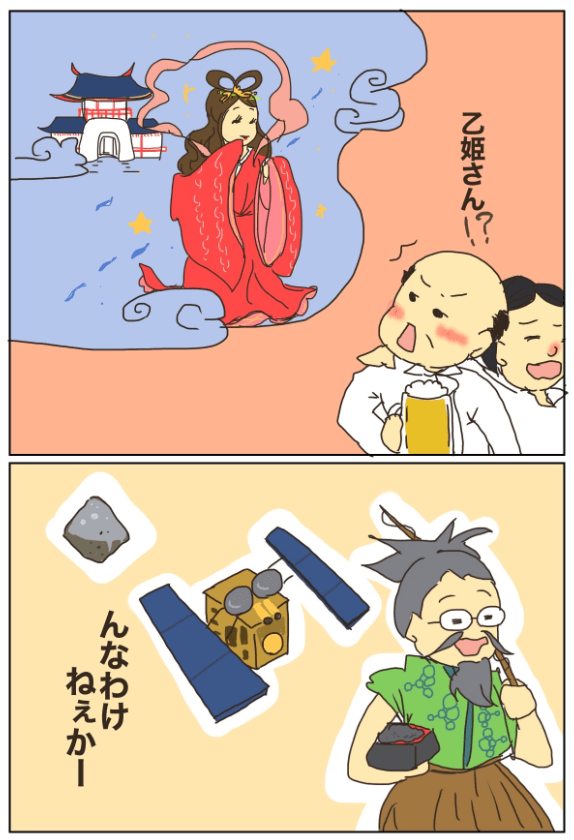【Column】Thinking about the sands of Ryugu

Author: Motoyoshi Okamura
● Why do amino acids exist stably in space?
As a result of component analysis of the Ryuguu sand brought back by Hayabusa2, 23 kinds of amino acids were detected. This is great news. The fact that the constituents of life on Earth were detected from space, where life forms cannot live, is expected to provide clues to understanding the birth of life.
In a space environment that is too harsh for amino acid molecules to exist, how is it possible that they have existed for billions of years without breaking apart? One reason is that the space environment is very different from the Earth’s environment. It is known that the temperature of the universe is -270°C, almost absolute zero (-273°C). At absolute zero, thermal motion of matter comes to a complete halt (entropy is zero), so no reactions such as decomposition can take place. This means that the best way to stably preserve materials, including pharmaceuticals and food, is to store them in space.
●What about the storage temperature of cells?
The temperature of liquid nitrogen used to store cell banks, which are the starting materials for biopharmaceutical production, is -196℃. In the author’s experience, CHO cells stored in liquid nitrogen for a long period of time have maintained an average survival rate of more than 95% after re-thawing, even after long-term storage for more than 10 years. Cells stored long-term (more than 5 years) in a deep freezer (-80°C) without a liquid nitrogen container had a clearly lower survival rate of 70% after remelting.
Furthermore, when the deep freezer was full and we had no choice but to store the cells in a regular freezer (-20°C), the temperature was not high enough to completely stop the cells’ biological activities, and the cells died. Extrapolating the 10-year survival rate of liquid nitrogen storage to the 50-year life cycle of commercial pharmaceuticals, it is clear that long-term storage stability can be obtained without practical problems, so liquid nitrogen storage of cell banks is appropriate. If it becomes possible to store cell banks and protein pharmaceuticals in space, the stability of cell banks and pharmaceuticals will be permanently maintained.
●What is the process of peptide and protein synthesis?
Although we should not make easy assumptions based on information obtained by sampling a handful of samples from the vast and mind-boggling universe, the 23 amino acids found include 10 natural forms (L-body) detected in only 5 g of sand, even if we exclude optical isomers (D-body), which are not found in living organisms. It would be a shame to dismiss as mere “coincidence” the fact that the 10 natural forms (L-body) were detected in only 5 grams of sand and that the amino acids that make up our bodies match. Our bodies are made up of 20 types of amino acid proteins, which are cleverly catabolized and assimilated in cells for use in biological activities.
The main amino acid metabolism is the TCA cycle, which occurs in the mitochondria1) (Fig. 1). While the synthesis of the amino acids contained in the sand probably took billions of years, amino acid catabolism by the intracellular TCA cycle reaction is completed in a few hours. Alanine (Ala), for example, is ingested as protein as food and broken down into amino acid molecules by degradative enzymes → Ala taken into the cell as a nutrient is converted to pyruvate → pyruvate is converted to acetyl CoA by pyruvate dehydrogenase → acetyl CoA acts on oxaloacetic acid Citric acid is converted to isocitric acid, succinic acid, fumaric acid, malic acid, etc., by enzymes and returns to citric acid. In this reaction cycle, energy is extracted via NAD and NADH conversion reactions, and water molecules This is happening in the mitochondria of the cell simultaneously for 20 different amino acids. The cell is like a short condensation of reactions in the universe.
●It looks like a coincidence, but it is inevitable.
The creation of peptides and proteins necessary for health and the treatment of disease by the cells that make up our bodies is surely a great invention, the culmination of the wisdom of humankind. It would take a tremendous amount of man-hours to perform all the reactions that take place in a cell in a test tube. To infer the synthesis process of amino acids, peptides, and proteins in cosmic time, from the birth of the universe to the present, is unacceptable from the human time scale.
We tend to regard the fact that the 10 L-body amino acids detected in this study match the amino acids that make up living organisms as a “coincidence,” but on the cosmic time axis, it is an “inevitability. We may have no choice but to accept the message from Ryuguu in our imaginations. On the other hand, if the pathways of amino acid metabolism and protein biosynthesis in cells are understood in more detail, we can expect that it will provide clues to the birth of life in the universe. In addition, carbon isotope (C14) measurements have been used to identify the age of ancient organisms. The amino acid skeleton has one carbon. It would be interesting to obtain information leading to the elucidation of the formation age (in hundreds of millions of years) and the origin of life from isotopic analysis of carbon (C) in the amino acids contained in the Ryuguu sand.
